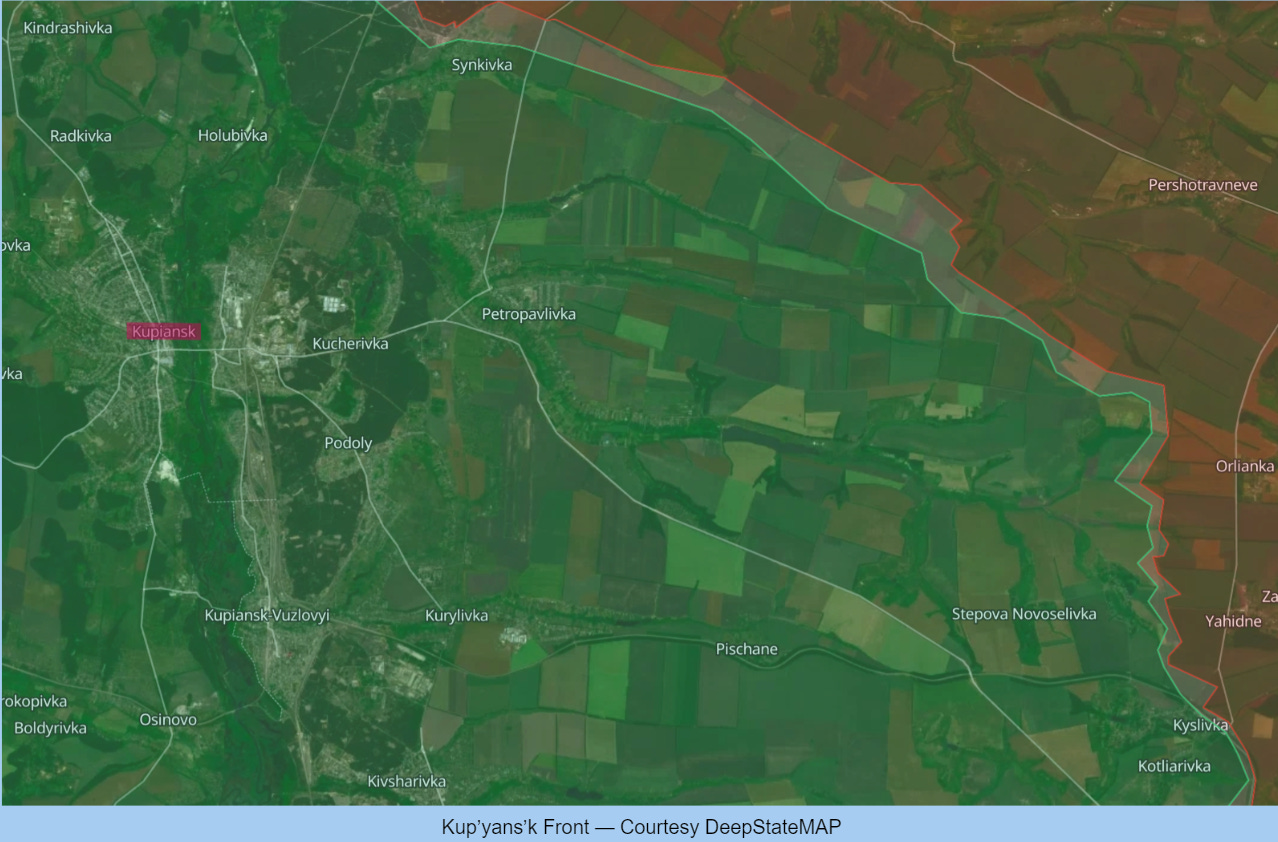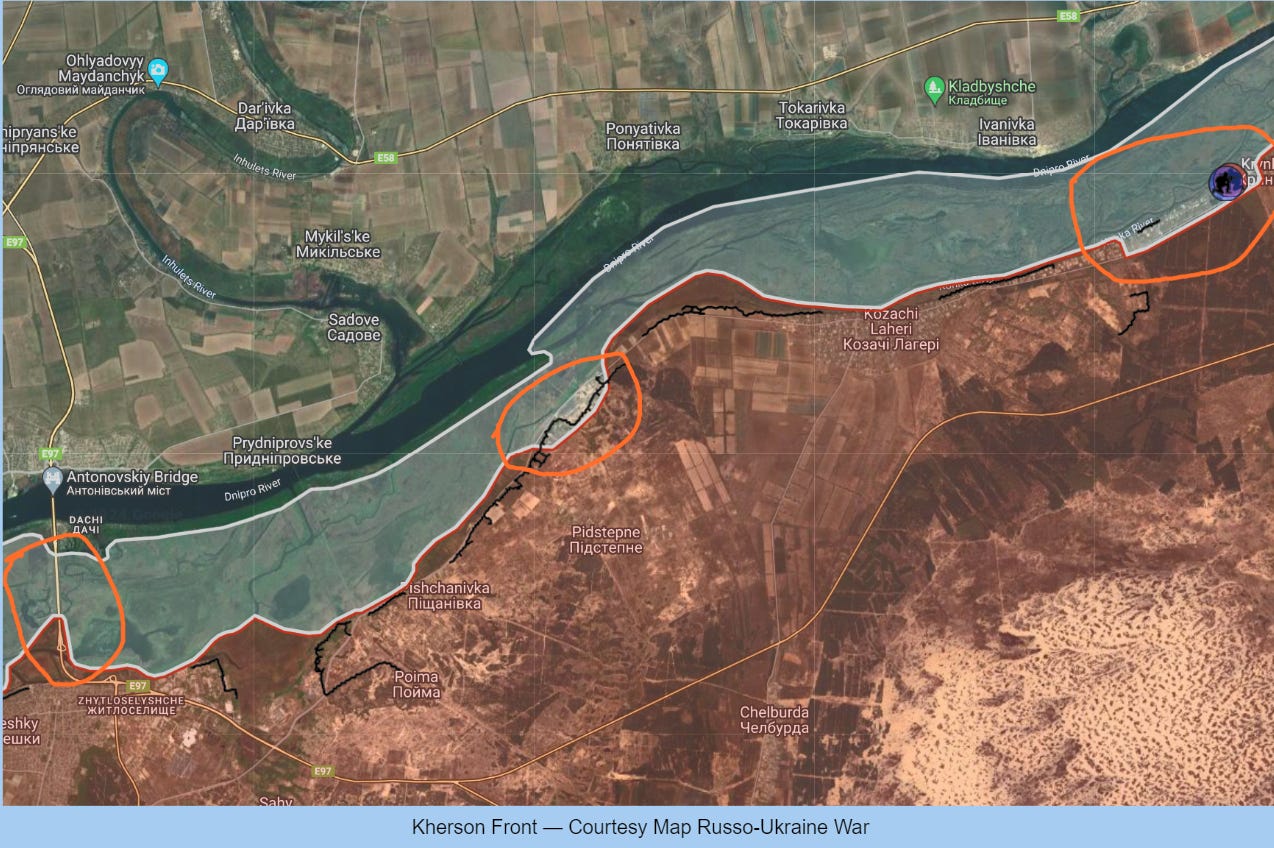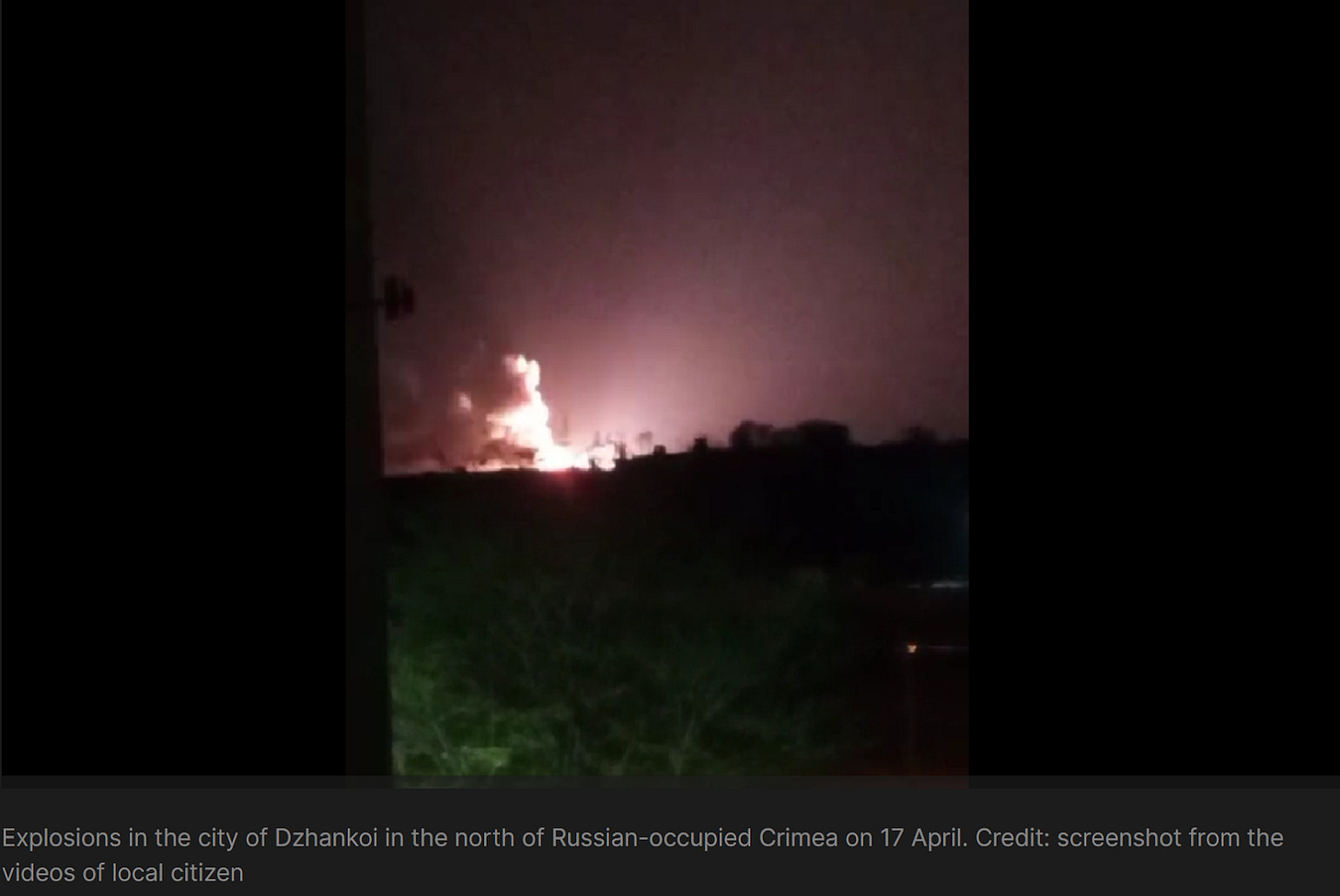Slava Ukraini! In early 2022 I began a Telegram channel aggregating news from a number of sources daily on the war in Ukraine. Since June 2023 I have provided a daily draft for the Ukraine War Brief Podcast collecting news from over 60 sources daily, much of which forms the basis of the script. While the Podcast is on hiatus I will make this Draft available here both on my own Substack and The People’s Media for those who wish to keep up with events on a daily basis.
INSIDE UKRAINE
ALONG THE CONTACT LINE
GSAFU Morning Report
The General Staff of the Armed Forces of Ukraine in its situation update at 06:00 on Apr. 17 stated that it was day 784 of the full-scale invasion of the Russian Federation against Ukraine.
During the past day, 68 combat engagements took place. Over the past 24 hours, the enemy carried out 2 missile strikes, 64 air strikes, and 75 MLRS attacks across the positions of our troops and settlements. As a result of the Russian attacks, unfortunately, there are dead and wounded among the civilian population. Destruction and damage to residential buildings and other civilian infrastructure.
At the same time, Ukrainian soldiers continue to inflict losses in manpower and equipment on the occupying troops, exhausting the enemy along the entire front line.
Ukrainian missile forces struck 1 concentration of russian troops.
ISW – Ukrainian ammo shortages hinder defense against even depleted Russian forces
The Institute for the Study of War in their Apr.16 Russian Offensive Campaign Assessment assessed that Russian forces in eastern Ukraine are using smaller groups to conduct assaults and are reportedly suffering from morale issues, but Russian attacks are unlikely to culminate in the near term despite these challenges because of Ukrainian materiel shortages.
Spokesperson of the Ukrainian National Guard Colonel Ruslan Muzychuk stated that Russian forces in eastern Ukraine have not recently used large units to conduct assaults but are instead using groups split into two detachments reinforced with armored vehicles to conduct ground attacks. Muzychuk stated that Russian forces are also using small vehicles without protection to approach Ukrainian positions quickly and set conditions for a subsequent Russian infantry group to secure these positions. Muzychuk reported that Ukrainian drones destroyed about 70 percent of Russian armored vehicles last week, although it is unclear if Muzychuk is claiming that Ukrainian drones actually destroyed armored vehicles or temporarily rendered them hors de combat.
The press officer for the Ukrainian 26th Artillery Brigade, Oleh Kalashnikov stated that Russian forces in the Bakhmut direction are not conducting battalion-sized ground attacks because Ukrainian drones immediately detect them and that Russian forces are instead using company-sized groups at most. Kalashnikov stated that Russian forces in the Bakhmut direction are suffering from low morale and are also using barrier troops to prevent Russian soldiers from retreating.
Russian forces previously used mass infantry-led frontal assaults in their seizure of Bakhmut and in the beginning of the Russian effort to seize Avdiivka, but Russian forces appear to have shifted to using smaller infantry groups recently to conduct ground attacks.
Russian sources have also recently indicated that Russian forces suffered from exhaustion and lacked rotations but had to continue to fight on new lines west of Avdiivka following Russia’s seizure of Avdiivka.
ISW has previously (and not always accurately) assessed how low Russian morale and exhaustion affected the prospects of Russian offensive operations, but Ukraine’s current material shortages may make it difficult for Ukrainian forces to defend against Russian forces — even those that are exhausted and unmotivated. ISW continues to assess that Russia’s opportunities to exploit Ukrainian vulnerabilities will widen as Ukrainian materiel shortages persist.
Air Force Daily Report
The Ukrainian Air Force in its situation update at 06:00 stated that during the previous day they launched air strikes on 6 concentrations of troops, 2 command posts.
The Khortytsia operational-strategic group
(Responsible for the Kup’yans’k, Lyman, and Bakhmut axes, in the northeastern part of Ukraine. )
Kup’yans’k axis: The enemy did not conduct any offensive (assault) operations in this area. Ukrainian Defense Forces continue to hold their positions.
Lyman axis: Ukrainian defenders repelled 8 attacks near Terny and Tors’ke and Hryhorivka (Donetsk oblast), plus Serebryans’ke forestry (Luhansk oblast) where the occupiers attempted to breach Ukrainian defensive lines.
Bakhmut axis: Ukrainian forces repelled 19 Russian attacks, supported by aviation, in the vicinities of Bilohorivka (Luhansk oblast) Verkhn’okam’yans’ke, Vyimka, Chasiv Yar, Ivanivskie, and Klishchiivka (Donetsk oblast).
The Tavria operational-strategic group
(Responsible for the Avdiivka, Novopavlivka, and Orikhiv axes, in the central-eastern and southeastern part of Ukraine.)
Avdiivka axis: Ukrainian defenders repelled 11 enemy attacks in the vicinities of settlements of Novokalynove, Ocheretyne, Berdychi, Semenivka, Netailove and Pervomais’ke, (Donetsk oblast) where the invaders, with air support, attempted to dislodge Ukrainian troops from their positions.
Novopavlivka axis: Ukrainian Defense Forces continue to hold back the enemy in the vicinities of Krasnohorivka, and Novomykhailivka (Donetsk oblast). The enemy made 20 attempts, assisted by air support, to breach Ukrainian defense in that area.
Orikhiv axis: The enemy conducted 9 assauts on positions of Ukrainian defenders in the vicinities of Staromaiors’ke (Donetsk oblast), Robotyne and northwest of Verbove (Zaporizhzhia oblast).
The Odesa operational-strategic group
(Responsible for Kherson, Qırım, (also known as Crimea) and the Black Sea.)
Kherson axis: Ukrainian defenders continue to maintain their positions. Over the past day, the enemy carried out 5 unsuccessful assaults on the positions of the Ukrainian Defence Forces on the left bank of the Dnipro River.
TEMPORARILY OCCUPIED TERRITORIES
Dzhankoi airfield in occupied Qirim targeted in strikes
The Dzhankoi military airfield, home to Russia’s 39th Helicopter Regiment deployed in occupied Qirim, came under attack overnight with a series of explosions reported at the site.
A series of explosions occurred during the night of 17 April in the area of the military airfield in the city of Dzhankoi in the north of Russian-occupied Crimea.
Russian Telegram channel Astra and local citizens reported that a fire broke out at the facility in Dzhankoi. There are no details yet on whether any equipment was destroyed.
Dzhankoi is a military airfield in Russian-occupied Crimea, where the 39th Helicopter Regiment of the 27th Combined Aviation Division of the Russian Forces is deployed, along with three aviation squadrons.
Ukraine has not confirmed the responsibility for the explosions in Crimea. However, in recent months, Ukraine has intensified its attacks on occupied Crimea, targeting Russian military bases, which Russia used to attack Ukraine.
THE HOME FRONT
Russian morning attack on Chernihiv kills 14, injures 61, including 3 children
Russian forces launched three missile strikes on a civilian infrastructure facility almost in the center of Chernihiv on the morning of Apr. 17, Chernihiv Oblast Head Viacheslav Chaus reported. As a result, several floors of an annex to this building were damaged.
“There are civilian casualties, many injured. Rescuers and medics are working on-site. All necessary assistance will be provided,” the Governor wrote on Telegram.
As of 15:00 pm, the number of dead due to the attack rose to 14, and injured to 61, including three children. A 25-year-old police lieutenant was among the dead. According to reports, three people are still unaccounted for.
Defence Minister – Ukraine Defense Industrial Base is expanding rapidly.
Ukraine’s Defense Minister Rustem Umerov, in an article for Ukrainska Pravda, outlined the ongoing reforms and reported that over six months, his ministry had approved 344 new weapon systems and military equipment for use by the Armed Forces. Notably, 244 of these 344 systems, equating to over 70%, are produced domestically within Ukraine.
Umerov detailed the ministry’s efforts to streamline the approval process for new equipment, reducing the time required for operational clearance from months to just 20 days. This expedited timeline has enabled the Ukrainian military to more rapidly field essential capabilities to troops on the frontlines.
Rustem Umerov emphasized that 47 of the newly approved systems were unmanned aerial vehicles (UAVs), and 31 were electronic warfare (EW) platforms. He stressed the importance of these emerging technologies in the current conflict, noting that “modern war cannot be imagined without drones and electronic warfare.”
The Defense Minister also highlighted the ministry’s work to build international defense coalitions through the Ramstein Contact Group format. Eight separate capability-focused coalitions have been established with partner countries, allowing Ukraine to secure commitments for increased supplies of critical weaponry such as artillery munitions, air defense missiles, and unmanned aerial systems.
RUSSIAN WORLD
Nothing to report.
NEWS WORLDWIDE
US fears Russia is beginning to see signs of fatigue among Ukraine's allies
US Treasury Secretary Janet Yellen has said that the United States and the G7 countries are "absolutely committed" to supporting Ukraine and called on Congress to approve urgent military and budget support. Reuters reports.
Yellen said that she fears that Russia may be emboldened by domestic debates in the United States and other countries about continuing to help Ukraine.
"I do fear that Russia is beginning to see signs that the U.S. and our allies are tiring, or finding it more difficult to find ways to support Ukraine, and that gives them hope that they can outlast us and wait for our resolve to crumble," she said.
Grumpy Here — I hope she was looking into a mirror when she said that. Say it ain’t so Janet, I wonder what could be giving people that impression?
MILITARY & TECH
The Czech Republic received funds to purchase 500,000 shells for Ukraine
Facing a six-month delay in US military aid and unfulfilled EU promises, an initiative by the Czech Republic has garnered support from approximately 20 countries, collectively pledging to provide 500,000 rounds of much-needed shells. Euromaidan reported.
Czech Prime Minister Petr Fiala said on 16 April that 20 countries that joined the Czech initiative to purchase artillery ammunition for Ukraine’s Defense Forces promised to provide funds to acquire 500,000 rounds of ammunition.
Ukraine faces a significant artillery ammunition shortage due to a six-month delay in US military aid and the European Union’s inability to fulfill its promises of providing 1 million shells.
“Around 20 countries have already joined our initiative – from Canada, Germany and the Netherlands to Poland,” Fiala said during a speech in Washington. “We can now provide around 500,000 artillery rounds. We believe there will be more deliveries to come.”
Fiala said this initiative is not a one-off project. “Our goal is to create a long-term system for supplying ammunition for heavy weapons. This will directly help change the situation on the front lines,” he said.
Ukraine to receive tactical drones from its allies
Canada will send 450 SkyRanger R70 multi-mission Unmanned Aerial Systems to Ukraine this summer. In February 2024, Canadian Defense Minister Bill Blair announced that Canada would deliver 800 such systems to Kyiv. The country would fund the transfer through $500 million in military assistance allocated earlier.
SkyRanger R70 is a multi-mission unmanned aerial system developed by the US company Teledyne FLIR. It includes multirotor unmanned aerial vehicles (UAVs) capable of vertical takeoff and landing and performing reconnaissance and logistical tasks, as per mil.in.ua.
The Ukrainian Defence Ministry also noted that the Netherlands and Germany will jointly purchase RQ-35 Heidrun reconnaissance drones worth €200 million
The RQ-35 Heidrun is manufactured by the Danish company Sky Watch. The drone is capable of flying up to 25 kilometres. Autonomous flight time is 1.5 hours. The UAV can transmit video images in real time. This allows to receive intelligence without endangering the operator. The drone is able to resist electronic warfare. The AFU has been using the RQ-35 Heidrun since the beginning of the full-scale war.
Additionally, Germany will supply 105 VECTOR 211 reconnaissance UAVs to Ukraine.
The Vector UAV is equipped with electro-optical and infrared sensors, which allows it to detect enemy targets around the clock, and the robust design of the drone eliminates the influence of weather factors. Speed - up to 72 km/h. The duration of one flight is 120 minutes.
The drone is equipped with advanced artificial intelligence capabilities for data analysis: built-in algorithms allow you to automatically identify objects and immediately transmit critical intelligence information to the ground.
Netherlands sends three more F-16s to Romania for Ukrainian pilot training
On 17 April, the Dutch Armed Forces delivered three additional F-16s to the European F-16 Training Center (EFTC) in Romania, which was established last year at the George Mocorlat Air Base in Borcea. This transfer was marked by a meeting between Romanian Defense Minister Angel Tilvar and his Dutch counterpart Kajsa Ollongren. Reported Minister Tilvar on Twitter
The Netherlands, along with Denmark and the United States, is leading the international effort to bolster Ukraine’s air defense capabilities by providing F-16 fighter jets. Ukrainian pilots are set to begin training at the EFTC in Romania to operate these aircraft in the near future, said Angel Tilvar.
Ukraine's forces to receive 2,000 Ukrainian-made short-range electronic warfare systems
Mykhailo Fedorov, Ukraine's Deputy Prime Minister for Innovation and Minister of Digital Transformation, has announced that 2,000 items of Ukrainian-made short-range electronic warfare equipment developed by Brave1 cluster companies will be deployed to the battlefield.
"Short-range electronic warfare, particularly for trench warfare, protects soldiers and their locations, armoured vehicles, and evacuation cars. It disables Russian FPV drones, scavenger drones and reconnaissance drones. That means tens of thousands of lives and pieces of equipment saved."
— Mykhailo Fedorov, Ukraine's Deputy Prime Minister
According to Fedorov, there was no development of short-range electronic warfare in Ukraine before the full-scale invasion. Thanks to Brave1's systematic work, the industry has begun to expand, and there are now hundreds of technological solutions available for purchase by the state.
The digital transformation minister added that he would continue to sign new contracts.
"Our strategic goal is to ensure that every unit and every piece of equipment that needs EW protection gets it. And Brave1's objective remains to discover and support developers working to boost the military technologically." he said
That’s it for today’s Draft folks if you would like to keep up with events in Ukraine daily please consider subscribing, its free!
Feel free to share this update with your friends. Heroyam Slava!



























